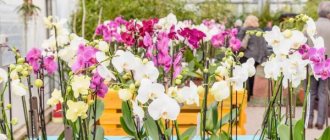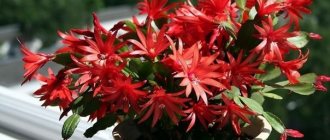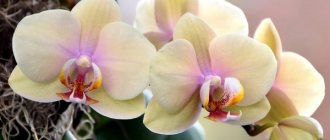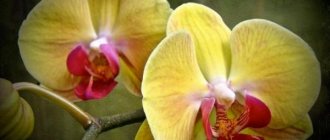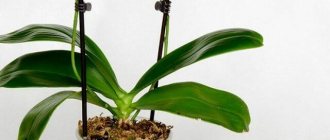When is an orchid ready to bloom?
Usually you buy a flowering plant in a store - this is the only way to determine the type, size and shade of the resulting flower. Since moving an orchid to a new room is always a certain stress, the first flowering usually does not last long. The peduncle, along with the buds, dries up and falls off, and the plant enters a period of relative dormancy.
The duration of this condition depends on the purchased variety. The most frequent guests of this family on our windowsills are Phalaenopsis. They are not very demanding on living conditions, so they are ready to bloom within 2-2.5 months after the last flowering.
In the meantime, the plant turns its main forces to the foliage: it forms new leaves and saturates them with green color. It is this saturation that is a kind of signal that the culture is ready to bloom.
Different types of decorative orchids prefer to do this at certain times of the year:
- Phalaenopsis and Paphidopellum usually produce flower stalks in winter, from November to March;
- Cymbidiums and Dendrobiums - from October to February, but they also bloom in summer;
- The flowering period of Oncidiums begins in April and usually ends in June;
- Miltonias are pleasing to the eye in spring or autumn;
- Cattleyas - from spring to the first days of winter.
IMPORTANT! Knowing this biological calendar, you need to buy different types of orchids during their traditional flowering period. Plants with a disrupted biological cycle get sick more often and grow worse.
The flowering process itself can last from a month to six months. There are known cases when buds periodically formed on one peduncle over a period of 8-10 months.
When does flowering occur at home?
Different varieties of orchids begin to bloom at different ages . Usually the first buds appear when the flower is 1.5-3 years old. You can find out the age of an orchid by its shoots: if the plant is 2 years old or more, then there should be at least 5-8 of them.
Attention : Botany knows more than 30 thousand natural varieties of flowering orchids and the same number of artificially bred species of this plant.
After the orchid has bloomed and its peduncle has dried, you can wait for the next flowering no earlier than in 2-3 months. This fact is due to the fact that a healthy plant, with proper care, can generate flower stalks only 2-3 times a year , and the duration of flowering itself is usually about 3 months. However, not all orchids obey the general rules, and the reason for this is often the incorrect conditions of their maintenance and the owners’ ignorance of how to act correctly to achieve flowering.
Why doesn't it bloom?
So, we have decided on the rest period. But it happens that the time for flowering according to the natural schedule seems to have arrived, but there are no signs of the formation of a peduncle. There may be several reasons for this. Orchid is a capricious crop and requires certain rules of care.
Improper watering
An orchid is watered in several ways. This can be surface watering from a watering can. Many people do it using the immersion method, lowering the flower pot into a container of water for 15 minutes. Through drainage holes, water saturates the soil to the required consistency.
It is very important to comply with certain conditions of this procedure:
- Excessive watering is just as harmful as infrequent watering. The substrate should be irrigated as it dries (usually 1-2 times a week), then the root system will be healthy and capable of feeding flower stalks;
- cold water can chill the roots, which makes them sick, and the plant is no longer interested in flowers. Water the flower with warm, settled water;
- If water during watering gets into the axils of the leaves, from where flower stalks begin to grow, it stagnates there. The process of rotting begins, and flowering is no longer out of the question.
IMPORTANT! Excessive watering is harmful for two reasons: it activates the growth of leaves to the detriment of flower stalks and leads to rotting of the roots. In both cases, the orchid will not be able to bloom.
The process of decay can be determined by the color of the roots. In affected plants they begin to darken.
Unsuitable substrate
Phalaenopsis is the most common and unpretentious type of orchid. But they are also very demanding on the composition of the substrate - the soil in which the plant is grown. It can be purchased at a special store, but it is quite possible to make the mixture yourself. Here is one such recipe.
The substrate requires the following components:
- bark of coniferous trees, larch or oak; you just need to make sure that there is no resin on it;
- agroperlite is a porous substance of volcanic origin; does not nourish the plant, but protects it from rot;
- sphagnum moss – collected on moist soil in the forest is quite suitable;
- peat with sand particles;
- coconut fibers.
This composition forms porous, nutritious soil where the plant’s roots will develop freely and be saturated with oxygen.
IMPORTANT! Just soil from the forest or store-bought soil is not suitable for orchids, they are too dense. The delicate roots of Phalaenopsis are not able to develop and breathe there.
It is clear that an underdeveloped root system will not contribute to the formation and growth of flower stalks. In dense soil they begin to die off very quickly.
Moving in space
Orchids do not tolerate any movement well, so this should not be done often. In nature, such flowers grow all their lives in one place, and therefore bloom profusely.
You should limit yourself to the following principles:
- closer to winter, it is permissible to move the flower to a cooler and shaded place;
- you can rearrange the pot after replanting - the crop will still adapt to the new conditions;
- Phalaenopsis are sensitive to changes in lighting conditions (even minor ones); moving from window sill to window sill will force the plant to devote all its energy to adaptation, and not to the formation of a peduncle.
Insufficient lighting
An immutable rule: an orchid will never bloom in low light conditions. Other conditions must also be met:
- the light should be diffused, like in a tropical forest;
- direct sunlight in summer can cause burns of the leaves, and there will no longer be a peduncle in their axils;
- if flowering is expected in winter, it is necessary to extend natural light with additional lighting, otherwise buds will not form.
Incorrect temperature
The conditions of detention should be as follows:
- in summer, temperatures from 15 to 30 degrees are permissible;
- in winter – from 20 to 23 °C;
- during the period of flower stalk formation, it is necessary to ensure a difference in night and day temperatures of 5-7 degrees; the process will take place in conditions close to natural, which will be the most suitable regime for the orchid.
Orchid pruning
This term usually refers to cutting off the peduncle. If the peduncle is completely dry, it is removed. The living peduncle of phalaenopsis is not cut off after flowering, since it is on it that the buds are located, from which new arrows will appear.
At the same time, trimming the peduncle is a good way to make a phalaenopsis orchid bloom at home a second time. After flowering, the phalaenopsis is cut off the peduncle two centimeters above the dormant bud from which it would be desirable to get a new arrow. The closer the peduncle is cut to the rosette, the more abundant the next flowering will be.
What should I do to make it bloom?
After all possible errors in keeping orchids have been corrected, you can begin to create optimal conditions for the start of flowering. There are several options for stimulating the plant that do not present any particular difficulties.
Creating optimal conditions
With the right soil, watering and temperature conditions, it remains to take care of several more conditions necessary for the orchid to bloom:
- Phalaenopsis blooms best on the south side, only it should be slightly shaded;
- the most suitable flowerpots are transparent, the condition of the roots can be seen in them;
- The daytime temperature should be kept around 22 degrees, the nighttime temperature should be reduced to 15; in the summer, the pet can be taken out to the balcony at night;
- You should organize regular feeding of the plant with store-bought preparations; Fertilizer application is stopped at the beginning of flowering.
IMPORTANT! To form a peduncle, you need to create conditions for the culture that are as close to natural as possible. Then the flowering will be long.
The age of the flower is also of great importance if you grow it yourself. In different varieties, the first formation of peduncles varies at the age of 1.5 to 3 years. Usually by this time 5-7 full-fledged leaves have already formed on the plant.
Drought simulation
Sometimes you have to resort to more drastic measures. The homeland of most wild orchids is the tropics, where heavy rains are followed by drought. You can simulate drought at home by reducing watering by approximately 2 times and completely removing fertilizing. Under these conditions, the flower usually begins to form peduncles, feeling the lack of usual comfort.
The process will then go like this:
- artificial drought will reduce the nitrogen content in the substrate, which causes the growth of leaves, but not flowers;
- the process of “education” can last up to a week, however, provided that the room temperature is no higher than 30 degrees;
- There is no need to spray the plant at this time either;
- after the first arrow appears, watering is resumed, but without fertilizing.
IMPORTANT! This method is only suitable for absolutely healthy specimens. A weak flower may die due to lack of moisture and overdried substrate.
The method should be used only by carefully monitoring the “pet”. At the first signs of flower lethargy, watering is transferred to normal mode.
Warm shower
To carry out this procedure, you need to heat the water to 40 degrees and spray the plant. The features of the process are:
- The substrate is first covered with polyethylene.
- The flowerpot is placed in the bath and sprayed generously.
- Then leave until completely dry.
IMPORTANT! Tap hot water cannot be used; it contains impurities that can harm the crop.
Processing is carried out in approximately 15 seconds. If necessary, it is repeated after 10 days.
Simulation of the rainy season
Stimulation goes like this:
- water is heated to 30-35 °C;
- abundant watering is carried out within 3-4 days;
- then all irrigation is stopped for 2 weeks.
Orchid, what to do if the orchid does not bloom. If the orchid does not bloom: what to do, what to do?
Everything written above sounds attractive, doesn't it? But, as they say, “it was smooth on paper, but we encountered ravines.” So it is in floriculture. It’s nice to read advice and look at colorful pictures of flowering plants on the pages of portals. But it’s worth listening to the advice and understanding for yourself what to do if orchids don’t bloom for a year or even longer. This situation is no longer normal and signals that something is wrong with your beauty. But what exactly is worth figuring out.
First, remember that in order for orchids to bloom, they need to create the appropriate conditions:
- the root system must be able to provide complete photosynthesis; for this, part of the roots must be above the pot to absorb excess lag from the surrounding air, and the lower roots are placed on the sides of a special substrate in a transparent plastic or glass pot;
- the soil should not contain fresh sawdust, fresh bark or, God forbid, fresh manure - all these substances make it impossible to plant and release a peduncle;
- lighting should be diffused - under direct sunlight, the root system dies and dries out;
- the ambient air temperature should have a daily difference of 5 degrees Celsius - at night it is necessary to move the pot with the plant to a cooler place (in winter you can get out of this position by moving the orchid to the central heating radiator and away from it, but constant spraying with warm water is necessary) ;
- fertilizing should be carried out at least once every 10 days.
Everything seems to be done, but the orchid still doesn’t bloom: what to do in this case? You may need to apply some tricks that professional flower growers use. We'll talk about this further. In the meantime, it would be a good idea to learn how to replant an orchid correctly.
Nuances
There are several other reasons why flowering may not occur. All of them are somehow related to the conditions of detention.
If the orchid does not bloom for more than a year
Sometimes a flower needs to be literally awakened by a sudden change in conditions. But there may be other reasons:
- there will be no flower stalks even after another year if the substrate contains fresh bark, sawdust and especially fresh manure;
- the absence of aerial roots also impedes growth and flowering;
- An orchid does not bloom if it does not have enough nutrition.
If Phalaenopsis stopped producing buds
The reasons may be as follows:
- flower stalks without buds grow due to lack of light;
- This usually happens due to lack of humidity;
- buds fall off due to excessive fertilizer.
If only new leaves grow and no flowers appear
This phenomenon also happens often:
- the situation can be provoked by excess fertilizer;
- Often the container with the substrate is too spacious, the roots and leaves are not limited in growth;
- The most common reason for excessive leaf growth is that the substrate contains a lot of nitrogen; the grower needs to choose another fertilizer with a low content of the substance.
Proper and competent care and careful attitude of the gardener towards the orchid will allow you to enjoy the beautiful flowering of the exotic “guest” for a long time.
5 / 5 ( 1 voice )
FAQ
Below are frequently asked questions regarding the bloom (or lack thereof) of an orchid.
Fattens and does not produce a peduncle
If the peduncle does not appear for more than 6 months, the following must be done:
- Provide the plant with a 12-hour light regime. To do this, the pot should be placed on an east or southeast window. During hot periods, the flower must be shaded with sun-protective foil.
- Create a stressful situation by moving the orchid to a cool, dark place.
- Follow the recommended watering schedule.
- Ensure a comfortable temperature for the plant (during the day - 20-22 degrees, at night - 16-18 degrees above zero).
Gives only children
If the orchid does not bloom and only produces babies, you must:
- Adjust the temperature regime (see above) and provide the plant with a sufficient amount of diffused light (preferably placed under a fluorescent lamp).
- You can also reduce watering or not water at all for 2 weeks.
- And the last thing is to try to change the soil (so that the substrate is not saturated with a large amount of nutrients, which are present in abundance in purchased soil).
Just released the arrow
In most cases this is due to a lack of light. Therefore, the plant needs to be provided with bright, but at the same time diffused light, protecting it from exposure to direct sunlight.
Drops buds
If an orchid drops buds and flowers, it is urgent to reconsider the conditions of its maintenance:
- Provide intense light flow.
- Reduce the amount of fertilizer or eliminate it altogether (so that the plant can bloom).
- Avoid overheating or hypothermia.
- Keep away from heating devices.
- Regularly water and spray the stems and leaves of the plant.
Orchids may not bloom for many reasons, ranging from improper care to plant diseases and pests. Therefore, the first thing to do is to completely inspect the leaves (including the reverse side), stems and soil for the presence of parasitic individuals. In this case you can find:
- whitish cobwebs on the leaves;
- small holes;
- unpleasant smell, etc.
If there is none of this and the plant looks healthy, the reason must be sought in the conditions of its maintenance (lighting, watering, room temperature, etc.). After eliminating the problem factor, the orchid will certainly delight its owners with long and lush flowering.
The light from your window...
Where to place an orchid so that it blooms? On the windowsill, of course! It is there that she will have enough lighting for normal growth and development. After all, in natural conditions, tropics grow on the bark of trees in order to rise higher towards the sun.
Therefore, the room should be light. Don't have such a window sill? Immediately purchase a special lamp for additional illumination. Otherwise you will never see flowers.
Owners of southern and western window sills have a different problem. The harsh Russian summer often surprises. And direct sunlight burns the leaf plates great. But you shouldn’t drag the orchid pot to another window. It is enough to make a scattering screen. It can be white paper, thick tulle or even a piece of light fabric. There will be plenty of light, but it will not burn the tender leaves. Flowering will occur fairly quickly and will last a long time.
Individual approach to each type
Speaking about why an orchid does not bloom for a long time, it is important to note that each species requires individual care. You will usually find out about this from sellers, who will provide a printout with a detailed description.
The epiphytic type of orchid is most often found on sale ; it is tropical and requires a lot of light, and when it blooms, it pleases the owner with beautiful buds of bright color. When a problem arises with the development of a flower, it requires sudden climate changes, which are common in tropical latitudes.
In a regular flower shop you can find the Cambria variety (Miltonia, Oncidium and other hybrids). When bulbs are observed in these species, watering should be reduced several times. Older plants also require less moisture, in which case flowering will begin much faster.
More demanding varieties begin to grow only after changing the volume of watering and fertilizers. But if you take a break before the peduncle appears, growth may stop abruptly and it will take a long time to restore the regime.
There are also specimens whose development depends on the formation of the bulb. When it takes up a third of the entire plant, watering can be reduced. A particularly weakened flower first of all requires careful care, and if the condition can be normalized, at most small bulbs will grow, but there will be problems with flowering this season.
Large developed flowers, kept in the wrong conditions, can begin to bloom with small bulbs, but after the end of the process, its condition will noticeably worsen. This is due to the lifespan of the roots - only three years, then these roots die, the root system cannot deliver the required amount of moisture, and this slows down the development of the flower. Despite this problem, shoots and even buds may form, but they will not bloom.
There is also a variety of hybrids, usually phalaenopsis, which delights with its bright colors twice a year - in spring and autumn, but this will require good lighting. Many flower lovers violate the watering schedule when the holiday season begins, this applies to both stores and professional gardeners, and then the flowering schedule may go astray. Air temperature also affects the condition of the plant, especially if it is placed on a south-facing window. Then you need to slightly reduce watering and the first shoots will be observed in early spring.
A group of paphiopedilums is distinguished. They do not depend on temperature conditions; they need reduced watering at the right time. The topmost bud is the source of flowering ; the pot can be placed on the north window, but with proper care, flowering will still begin. Flower stalks in orchids begin to form precisely at moments when the climate changes, so it is quite possible to sometimes rearrange them and cause drought.
The most dangerous thing a gardener can do is overdo it with watering. At this moment, early bud vegetation is provoked. In appearance, everything is normal, growth continues, but at this moment peduncles, which are the foundation of development, are not formed. If excessive humidity persists for a long time, previously formed buds and bulbs may simply die.
The natural environment can be mountainous, in this case the climate is constantly humid, and abundant watering kills the process of laying full-fledged buds and, accordingly, flowering. Sometimes they may bloom for a very short time, but the point is in the growing season, which continues constantly.
At home, it is the rock orchids that delight their owners with constant flowering. And if, with the usual precipitation from 30 to 600 mm Hg. Art., reduce these indicators, the mature plant produces shoots that provide almost year-round flowering. But if you overdo it with watering, the lifespan of open buds will be reduced to 2-3 months. In this option, it is ideal to use different types of fertilizers, for example, Ovary or Bud, which support long-term flowering.
The earth in the porthole...
The wrong composition of the soil will not help your orchid produce a flower stalk. It might even get in the way. Some beginners are very afraid to replant a plant after purchasing it, especially if it is blooming. But the composition of the transport soil is designed for the normal existence of a tropical plant for about 3 months. In addition, it is stuffed with chemicals and stimulants.
Immediately after flowering, the orchid needs to be transplanted into a suitable substrate. You can buy it in the store, or you can assemble it yourself:
- deciduous tree bark chips
- small pieces of coal
- good fat humus
- high peat
- coarse sand
All this is taken in equal quantities, then mixed thoroughly. This composition is ideal for planting orchids at home. After transplantation, no more than six months will pass before it blooms again. The plant will just need some time to acclimatize and grow new roots.
Advice. Use clear pots with plenty of drainage holes. An orchid blooms only when its root system receives enough light and air. And it will be easier for you to control the condition of the roots.
Reasons why flower stalks do not form
When purchasing an orchid, it is worth considering that the producers grew it in the most optimal conditions. When a plant changes from a greenhouse environment to a home environment, it will certainly become stressed. Sometimes the changes are so drastic that flowering stops. In order for the relocation to go smoothly, it is important to create the most suitable environment for the orchids. It must meet certain requirements. If at least one of them is damaged, this will cause poor growth and lack of flowering.
Orchids come on sale from greenhouse conditions, which are difficult to maintain at home. However, it is important to provide plants with the necessary minimum of life as much as possible.
For normal development and abundant flowering, an orchid needs:
| Lighting | An orchid is a light-loving plant; lack of natural light is one of the common reasons for the lack of flowers. |
| Temperature | Another important factor is heat, without which flowering is impossible. For example, one of the most popular species, phalaenopsis, feels safe in winter within the range of +150 – +250. At lower temperatures the plant may freeze. In summer, the upper mark ranges from +280, but for many species and varieties, not higher than +300. For the formation of flower stalks and buds, the difference between day and night temperatures is extremely important. It ranges from 50 to 70. |
| For the formation of peduncles and buds in orchids, the difference between day and night temperatures is extremely important. It is 50 - 70. If this condition is violated, then flowering will not occur, even if all other factors are met perfectly. Bobokul Tukhtaev – Doctor of Biology Sci. Director of the Scientific and Production Center "Botanika", Tashkent | |
| Air humidity | Humidification plays a crucial role in the nutrition of orchids, since they receive nutrients only in a gaseous state from the environment. Optimal indicators correspond to 50% - 70%. Deviations upward or downward are permissible, but not more than 10%. |
| Aeration | Air should flow freely around the orchid, without stagnation. At the same time, there should be no drafts. |
| Soil substrate | The soil mixture for orchids is completely different from the traditional soil of other plants. It serves as a medium for anchoring roots, so its main component is pine bark. It provides reliable support for the root system, and also creates optimal aeration, preventing the substrate from compacting. Due to this, free evaporation occurs, which is necessary for the air supply of the plant. |
How and when to fertilize phalaenopsis
It is hardly possible to achieve abundant and long-lasting flowering with watering alone, without additional feeding. There are many ready-made preparations for caring for phalaenopsis on the market. Before choosing one of them, it is important to know some nuances about their composition and action.
Most orchid fertilizers include NPK nitrogen, phosphorus, potassium and trace elements. They differ from each other in the percentage of substances. For example, preparations with the highest nitrogen content are used during the period of active growth of leaves and roots. As soon as a peduncle appears, fertilizers that include this element are not used. It provokes excessive growth of green mass, and the plant does not have enough resources to form flower buds. During this period, you need to increase the amount of phosphorus and potassium.
“Do’s” and “don’ts” during flowering
If you managed to make the orchids bloom or at least send out arrows, do not think that now you can just admire a tropical flower and do nothing. Be sure to follow our tips to ensure flowering lasts as long as possible:
- remove faded flowers in a timely manner,
- tie the arrows so they don’t break,
- provide long daylight hours.
It is also worth knowing what not to do with an orchid during the period of budding and flowering.
- You cannot move the pot from place to place . In nature, flowers always grow in the same place, so any movement is stressful for them. If you need to temporarily move the potty, try to return it to its place so that it is in its original position.
- You can't spray flowers . Drops of water remaining on flowers for a long time can cause stains to appear and buds to drop. In addition, drops from the leaves can flow into the axils or core of the rosette, causing rot. Use only a spray bottle that can produce so-called water mist, and spray the plant from afar.
- You cannot suddenly change the conditions of detention . When transporting from the store, especially in winter, the orchid experiences extreme stress. This may cause it to drop already formed buds or flowers.
- Do not place the pot next to a fruit basket or a fading bouquet . Ripe fruits emit ethylene, which promotes rapid ripening of buds and aging of flowers. Therefore, such a proximity can lead to the rapid fading of the orchid or the shedding of flowers and buds. A vase with a fading bouquet left nearby gives a similar result.
- Fertilizers cannot be applied . After the flower stalk appears, fertilizers are usually no longer applied. If they do this, then in accordance with the instructions, but not more than 2 times a week. However, after the first flower opens (or better before this moment), fertilizing should be stopped completely. Otherwise, it may interrupt flowering and force the plant to drop its buds.


